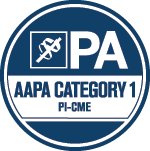AAPA Category 1 CME Credit
 American Academy of Physician Assistants (AAPA) AAPA is the only accreditor for the AAPA Category 1 CME system.
American Academy of Physician Assistants (AAPA) AAPA is the only accreditor for the AAPA Category 1 CME system.
The previous limit of 20 AAPA Category 1 CME for preceptors is no longer in effect. Preceptors may now earn an unlimited number of AAPA Category 1 CME for their precepting efforts from programs accredited by AAPA to provide these CME. Preceptorship CME is still earned at a rate of 2 AAPA Category 1 CME credits per PA student per 40-hour week. View the Category 1 CME for Preceptors Guide.
If you are interested in becoming a preceptor, please contact Heidi Kennedy, Clerkship Coordinator, at [email protected].
